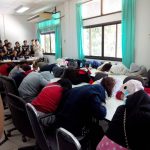AAT works to eliminate sexual exploitation through various different programs, aimed to cover the whole process of suppressing trafficking and sexual exploitation/abuse and to provide support to victims. Although AAT’s work focuses mostly on cases of trafficking in the form of forced prostitution, we also handle and provide support in other kinds of complex cases of commercial sexual exploitation (for example commercial surrogacy) and other kinds of sexual abuse (for example rape, or sexual abuse in a situation of labor trafficking).
AAT works using a regional approach, which means that we don’t limit our work to a certain geographic area but work wherever necessary. Our experience has shown that a transnational crime such as trafficking can’t be fought when limiting yourself to certain areas, and our staff must be ready to cross borders in their work in situations where it is not possible of efficient to cooperate with a partner who has strong presence in the geographical area concerned.


 Human trafficking is the recruitment, transport, receipt and harboring of people for the purpose of exploiting them sexually or exploiting their labor. It always includes some form of coercion or deceit to lure the victims into the situation and keep them there: for example debt bondage, threatening with hurting the victim’s family, etc. AAT concentrates on helping victims of trafficking for sexual abuse, whereas other organizations specialize in fighting labor trafficking. Most of AAT’s trafficking cases include trafficking for forced prostitution, but we have also handled other kinds of cases, such as a well-known case of trafficking for surrogacy.
Human trafficking is the recruitment, transport, receipt and harboring of people for the purpose of exploiting them sexually or exploiting their labor. It always includes some form of coercion or deceit to lure the victims into the situation and keep them there: for example debt bondage, threatening with hurting the victim’s family, etc. AAT concentrates on helping victims of trafficking for sexual abuse, whereas other organizations specialize in fighting labor trafficking. Most of AAT’s trafficking cases include trafficking for forced prostitution, but we have also handled other kinds of cases, such as a well-known case of trafficking for surrogacy. According to the United Nations, “sexual exploitation” means any actual or attempted abuse of a position of vulnerability, differential power, or trust, for sexual purposes, including, but not limited to, profiting monetarily, socially or politically from the sexual exploitation of another.” AAT works with all kinds of sexual exploitation but especially with prostitution, which we consider to be a form of exploitation. In the region where we work, a large part of persons exploited in prostitution are children – mostly girls between the ages of 15 and 17 but sometimes as young as 12.
According to the United Nations, “sexual exploitation” means any actual or attempted abuse of a position of vulnerability, differential power, or trust, for sexual purposes, including, but not limited to, profiting monetarily, socially or politically from the sexual exploitation of another.” AAT works with all kinds of sexual exploitation but especially with prostitution, which we consider to be a form of exploitation. In the region where we work, a large part of persons exploited in prostitution are children – mostly girls between the ages of 15 and 17 but sometimes as young as 12.